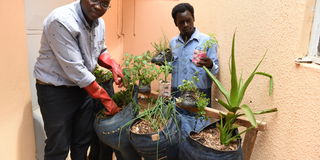How you can embrace vertical farming

A farmer explains how he grows his vegetables and herbs vertically. photo/ismael kezaala
What you need to know:
Vertical farming is similar to greenhouses where metal reflectors and artificial lighting increases natural sunlight. The primary goal of vertical farming is maximising crops output in a limited space
It is expert opinion that since land is becoming a limited factor to farmers in Africa amidst increasing population who need to be food secure, there is need to adopt upcoming technologies for food production on small piece of land.
This may mainly apply to the urban population who are urged to plant fast growing crops mainly vegetables and fruits in the available space.
One such technology is vertical farming which has been adopted in most developed countries, which is slowly penetrating in the African continent including Uganda.
Background
Agricultural experts define vertical farming as the practice of producing food on vertically inclined surfaces.
Instead of farming fast growing food crops such as vegetables, legumes and fruits on a single level in a field or a greenhouse, this method produces foods in vertically stacked layers commonly integrated into other structures such as repurposed warehouse or a wall fence.
Christine Alokit, a communications and extension scientist at Centre for Agricultural Biosciences International (Cabi), explains to Seeds of Gold that this modern idea uses indoor and open farming techniques.
“The artificial control of temperature, light, humidity and gases makes crop production easy though costly. However in many ways, vertical farming is similar to greenhouses where metal reflectors and artificial lighting increases natural sunlight. The primary goal of vertical farming is maximising crops output in a limited space,” she says.
Alokit contends that vertical farming is appropriate for people living in urban areas who in most cases go out to purchase dietary foods such as vegetables and fruits in supermarkets and open markets yet they can grow them in the available space in their homes.
To her it is a matter of setting up vertical structures either against the wall fence or using metal/wooden bars on the compound to grow any vegetable variety namely cabbages, nakati, sukuma wiki, tomatoes, onions, carrots and amaranth among others. The garden can be potted with sand using polythane bags where seed is planted.
The technology is also conducive in growing crops such as bush beans and groundnuts, among others on a small scale. The beauty is that a farmer is capable of growing the crops throughout the year while watering with the available water source on the compound.
According to Alokit, vertical farming technology has become attractive to the youth who have taken it as an enterprise initiative.
A number of youth in the country have set up their own associations and are willing to avail services for constructing vertical farm structures for people who are unable to do it on their own at a cost.
How vertical farming works
In a US based December 2020 publication namely sustainable businesses, experts analyse modalities of vertical farming as stated below.
The publishers contend that farmers wishing to venture into vertical farming, must understand the physical layout, lighting system whether natural or artificial, the growing medium mainly mixture of soil with manure and sustainability features.
The primary goal of vertical farming is to produce more food per square metre and to accomplish this goal farmers are expected to cultivate crops in stacked layers in a tower like structure. Secondly a perfect combination of natural and artificial lights is used to maintain the perfect light level in the room. Farmers who can afford may use technologies such as rotating beds which improve lighting efficiency. Farmers in developed countries prefer to apply aeroponic, aquaponic or hydroponic growing mediums where coconut husks and similar non-soil mediums are very common in vertical farming.
However in Uganda, farmers who are already embracing this technology use soil mixed with manure to grow crops of their choice.
It is sustainable because the consumption rate of agro inputs such as fertiliser and water are not so high.
The common types
According to Alokit, most farmers adopting this technology are those growing vegetable using sack gardening approach. “In most cases they fill the sacks with soil, make holes for the vegetables to sprout and water them occasionally. Instead of scattering the sacks all over the compound, farmers line them up in vertical order building a stair against the wall to produce what is enough for food and as income earning initiative,” says Alokit.
Another areas where the technology is adopted is by farmers growing passion fruit especially in most villages in Masaka where the sideway trellising system of making ropes run horizontally and the plants are spread sideways. The sideway trellising is the best because it makes the plants to spread well giving room to enough sunlight whereas the elaborate system leads to too much accumulation of shed which is not good for the plants growth.
When the plants are fully grown, it must be pruned and the farmer is expected to maintain three braches which compete for feeding from the same root point.
Vertical farming has a lot of promise and sounds like the farm of the future. However, there are a few stumbling blocks to consider before rushing full-speed ahead into vertical farming.
Trellising
The sideway trellising is the best because it makes the plants to spread well giving room to enough sunlight whereas the elaborate system leads to too much accumulation of shed which is not good for the plants growth.




